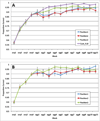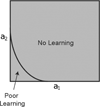Dopamine dependence in aggregate feedback learning: A computational cognitive neuroscience approach
- PMID: 27596541
- PMCID: PMC5077633
- DOI: 10.1016/j.bandc.2016.06.002
Dopamine dependence in aggregate feedback learning: A computational cognitive neuroscience approach
Abstract
Procedural learning of skills depends on dopamine-mediated striatal plasticity. Most prior work investigated single stimulus-response procedural learning followed by feedback. However, many skills include several actions that must be performed before feedback is available. A new procedural-learning task is developed in which three independent and successive unsupervised categorization responses receive aggregate feedback indicating either that all three responses were correct, or at least one response was incorrect. Experiment 1 showed superior learning of stimuli in position 3, and that learning in the first two positions was initially compromised, and then recovered. An extensive theoretical analysis that used parameter space partitioning found that a large class of procedural-learning models, which predict propagation of dopamine release from feedback to stimuli, and/or an eligibility trace, fail to fully account for these data. The analysis also suggested that any dopamine released to the second or third stimulus impaired categorization learning in the first and second positions. A second experiment tested and confirmed a novel prediction of this large class of procedural-learning models that if the to-be-learned actions are introduced one-by-one in succession then learning is much better if training begins with the first action (and works forwards) than if it begins with the last action (and works backwards).
Keywords: Computational cognitive neuroscience; Dopamine; Parameter space partitioning; Skill learning; Striatal plasticity.
Copyright © 2016 Elsevier Inc. All rights reserved.
Figures








Similar articles
-
Increasing dopamine levels in the brain improves feedback-based procedural learning in healthy participants: an artificial-grammar-learning experiment.Neuropsychologia. 2010 Sep;48(11):3193-7. doi: 10.1016/j.neuropsychologia.2010.06.024. Epub 2010 Jun 23. Neuropsychologia. 2010. PMID: 20600185 Clinical Trial.
-
Comparing the effects of positive and negative feedback in information-integration category learning.Mem Cognit. 2017 Jan;45(1):12-25. doi: 10.3758/s13421-016-0638-3. Mem Cognit. 2017. PMID: 27457097 Free PMC article.
-
Deferred feedback sharply dissociates implicit and explicit category learning.Psychol Sci. 2014 Feb;25(2):447-57. doi: 10.1177/0956797613509112. Epub 2013 Dec 13. Psychol Sci. 2014. PMID: 24335605 Free PMC article.
-
Feedback control of learning by the cerebello-olivary pathway.Prog Brain Res. 2014;210:103-19. doi: 10.1016/B978-0-444-63356-9.00005-4. Prog Brain Res. 2014. PMID: 24916291 Review.
-
Genetic association studies of performance monitoring and learning from feedback: the role of dopamine and serotonin.Neurosci Biobehav Rev. 2010 Apr;34(5):649-59. doi: 10.1016/j.neubiorev.2009.06.009. Epub 2009 Jun 27. Neurosci Biobehav Rev. 2010. PMID: 19563825 Review.
Cited by
-
Distinct Connectivity and Functionality of Aldehyde Dehydrogenase 1a1-Positive Nigrostriatal Dopaminergic Neurons in Motor Learning.Cell Rep. 2019 Jul 30;28(5):1167-1181.e7. doi: 10.1016/j.celrep.2019.06.095. Cell Rep. 2019. PMID: 31365862 Free PMC article.
-
Function and Regulation of ALDH1A1-Positive Nigrostriatal Dopaminergic Neurons in Motor Control and Parkinson's Disease.Front Neural Circuits. 2021 May 17;15:644776. doi: 10.3389/fncir.2021.644776. eCollection 2021. Front Neural Circuits. 2021. PMID: 34079441 Free PMC article. Review.
-
Perceptual category learning and visual processing: An exercise in computational cognitive neuroscience.Neural Netw. 2017 May;89:31-38. doi: 10.1016/j.neunet.2017.02.010. Epub 2017 Mar 6. Neural Netw. 2017. PMID: 28324757 Free PMC article.
-
Pitx3 deficiency promotes age-dependent alterations in striatal medium spiny neurons.Front Aging Neurosci. 2022 Sep 7;14:960479. doi: 10.3389/fnagi.2022.960479. eCollection 2022. Front Aging Neurosci. 2022. PMID: 36158557 Free PMC article.
-
Category learning in a recurrent neural network with reinforcement learning.Front Psychiatry. 2022 Oct 25;13:1008011. doi: 10.3389/fpsyt.2022.1008011. eCollection 2022. Front Psychiatry. 2022. PMID: 36387007 Free PMC article.
References
-
- Ashby FG, Alfonso-Reese LA, Turken AU, Waldron EM. A neuropsychological theory of multiple systems in category learning. Psychological Review. 1998;105:442–481. - PubMed
-
- Ashby FG, Casale MB. A model of dopamine modulated cortical activation. Neural Networks. 2003;16:973–984. - PubMed
-
- Ashby FG, Crossley MJ. A computational model of how cholinergic interneurons protect striatal-dependent learning. Journal of Cognitive Neuroscience. 2011;23:1549–1566. - PubMed
-
- Ashby FG, Ell SW, Waldron EM. Procedural learning in perceptual categorization. Memory & Cognition. 2003;31:1114–1125. - PubMed
MeSH terms
Substances
Grants and funding
LinkOut - more resources
Full Text Sources
Other Literature Sources

